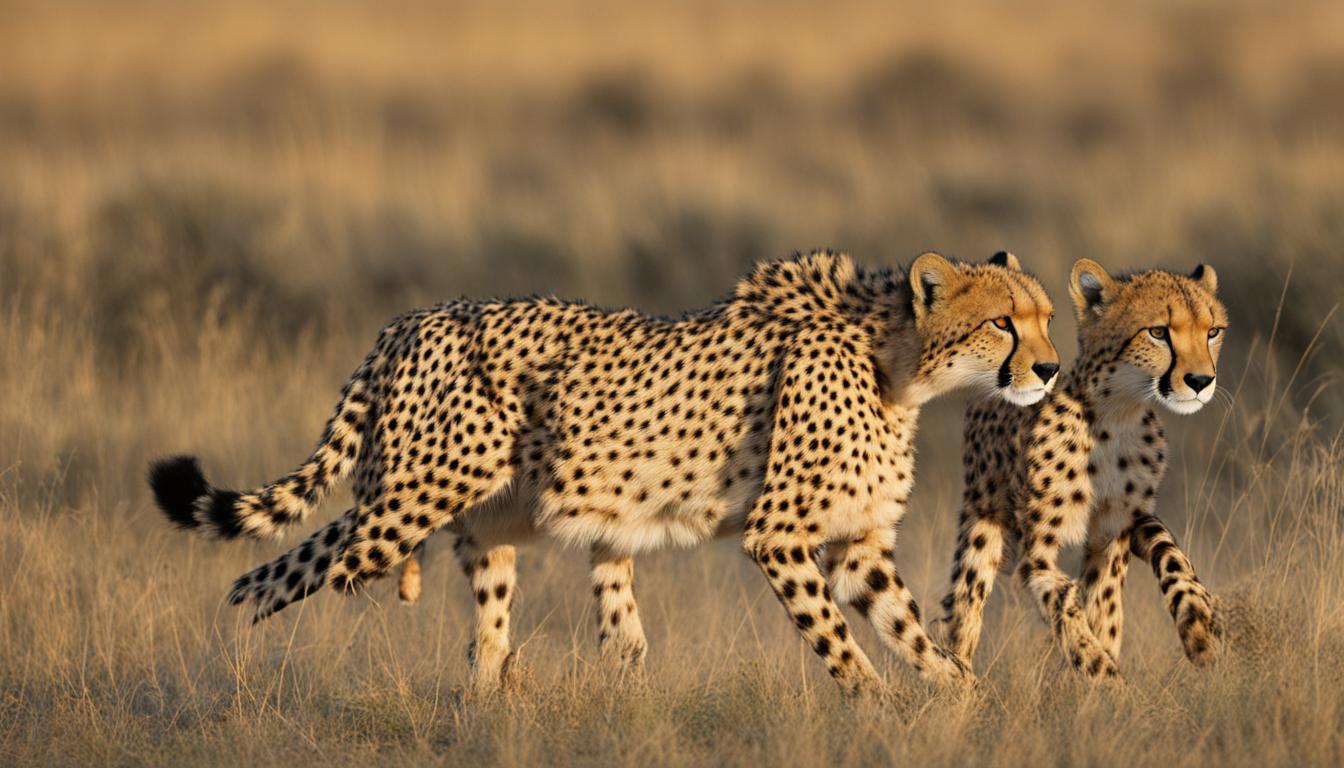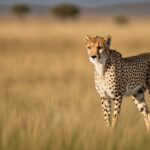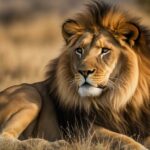If you’re fascinated by wildlife and love learning about the world’s fastest land animal, then cheetahs are sure to capture your attention. With their incredible speed, unique hunting techniques, and captivating physical characteristics, cheetahs are truly remarkable creatures.
As the fastest land animal on Earth, cheetahs can reach speeds of up to 112km/h in just three seconds. Their long legs, elongated spine, and adapted claws help them grip the ground and maintain balance while running at such impressive speeds.
Cheetahs have developed special hunting techniques to secure their prey. Using their exceptional eyesight, they scan their surroundings, stalk their prey, and then sprint to knock it down with a swift bite to the throat. A cheetah chase usually lasts less than a minute and covers a distance of 200-300m.
These magnificent creatures primarily hunt during the day to avoid competition from other predators like lions and hyenas. Their diet mainly consists of small animals such as rabbits, warthogs, and gazelles.
Cheetah Habitat and Population
Cheetahs can be found in diverse habitats across sub-Saharan Africa, from open grassy savannah plains to dense forests. They thrive in areas with abundant prey and sufficient cover for hunting, such as the Serengeti and Maasai Mara ecosystems. However, human activities have encroached upon their natural habitats, leading to habitat loss and fragmentation. This loss of suitable habitat has had a significant impact on cheetah populations.
A small population of cheetahs also exists in northeastern Iran, but their numbers are limited. These Iranian cheetahs face similar threats, including loss of habitat and prey, as well as poaching and illegal wildlife trade.
| Threats to Cheetah Population | Actions for Conservation |
|---|---|
| Habitat loss due to human expansion | Support habitat preservation initiatives |
| Loss of prey due to competition with other predators | Implement measures to improve prey availability |
| Human-wildlife conflict | Develop strategies to minimize conflicts and promote coexistence |
Cheetahs are currently classified as Vulnerable on the IUCN Red List, with an estimated population of 9,000-12,000 remaining in Africa. Conservation efforts are underway to protect and conserve cheetah populations. These initiatives focus on combating illegal trade, supporting habitat preservation, and implementing measures to address human-wildlife conflict. Strengthening law enforcement and raising awareness about the importance of cheetah conservation are also essential for ensuring the long-term survival of these magnificent creatures.
Cheetah Adaptations and Physical Characteristics
Cheetahs have evolved a remarkable set of adaptations that enable them to excel in their role as nature’s supreme sprinters. These adaptations make them perfectly suited for their high-speed hunting lifestyle.
Physical Structure
Their slender, aerodynamic bodies are built for speed, with a flexible spine, long legs, and a lightweight structure. This allows them to achieve their incredible acceleration and maintain top speeds during chases.
Their non-retractable claws and specialized paw pads provide superior traction on the ground, allowing them to make sharp turns and sudden changes in direction while chasing prey.
Oxygen Intake and Circulation
Cheetahs have large nostrils that facilitate the intake of oxygen-rich air, ensuring their muscles receive an adequate supply of oxygen during intense sprints.
They also possess a large heart and lungs, which work together to circulate oxygenated blood efficiently throughout their bodies, providing the necessary energy for high-speed pursuits.
Visual Adaptations
The distinctive tear marks on a cheetah’s face serve a functional purpose. They help reduce glare from the sun, enhancing their vision and focus during hunts.
With these physical adaptations, cheetahs can achieve astounding running speeds, going from zero to 60 miles per hour (97 kph) in just three seconds. In every stride, they cover approximately 21 feet (6 to 7 meters), allowing them to gain ground quickly and close the gap between them and their prey.
| Adaptation | Function |
|---|---|
| Flexible spine and long legs | Enable high-speed acceleration and maintain balance during sprints |
| Non-retractable claws and specialized paw pads | Provide superior traction for quick turns and changes in direction |
| Large nostrils | Facilitate the intake of oxygen-rich air for optimal muscle performance |
| Large heart and lungs | Efficiently circulate oxygenated blood for sustained energy during sprints |
| Tear marks on the face | Reduce sun glare, improving visual focus during hunts |
Cheetah Behavior and Social Structure
Cheetahs exhibit interesting and diverse behaviors that are influenced by their gender and life stage. Adult females, for example, are typically solitary, only coming together with males for mating purposes. On the other hand, male cheetahs often form coalitions with their brothers or other males to defend territories and hunt larger prey. These coalitions provide them with a greater chance of survival and success in hunting.
Female cheetahs have an important role in raising their cubs. They raise them alone, teaching them essential hunting skills and keeping them hidden in dens to protect them from potential predators. This period of maternal care is crucial for the cubs’ development and prepares them for their independent adult lives.
Cheetahs communicate through various vocalizations, including chirping, growling, hissing, and purring. These sounds serve different purposes, such as expressing aggression, warning other cheetahs of potential danger, or signaling mating readiness. Additionally, cheetahs use body language, such as tail movement and facial expressions, to convey their intentions and emotions.
Cheetah Behavior in the Wild
When it comes to hunting, cheetahs prefer to hunt during the day to avoid competition from other predators like lions and hyenas. Their hunting technique involves using their exceptional eyesight to scan the surroundings, stalking their prey, and then sprinting to knock it down with a bite to the throat. A cheetah chase typically lasts less than a minute and covers a distance of 200-300 meters, showcasing their incredible speed and agility.
It’s important to note that while cheetahs are known for their speed and hunting prowess, they are also vulnerable animals. They are more prone to stress and may easily lose their kills to more dominant predators. As a result, cheetahs have developed an adaptive behavior called “deferred feeding.” This behavior involves consuming their prey quickly and retreating to a safe distance to avoid losing their meal to opportunistic scavengers.
To understand cheetah behavior fully, researchers and conservationists continue to study their interactions in the wild. These efforts contribute to our knowledge of their social structure, communication methods, and overall behavior, which in turn helps us develop effective conservation strategies to protect this magnificent species.
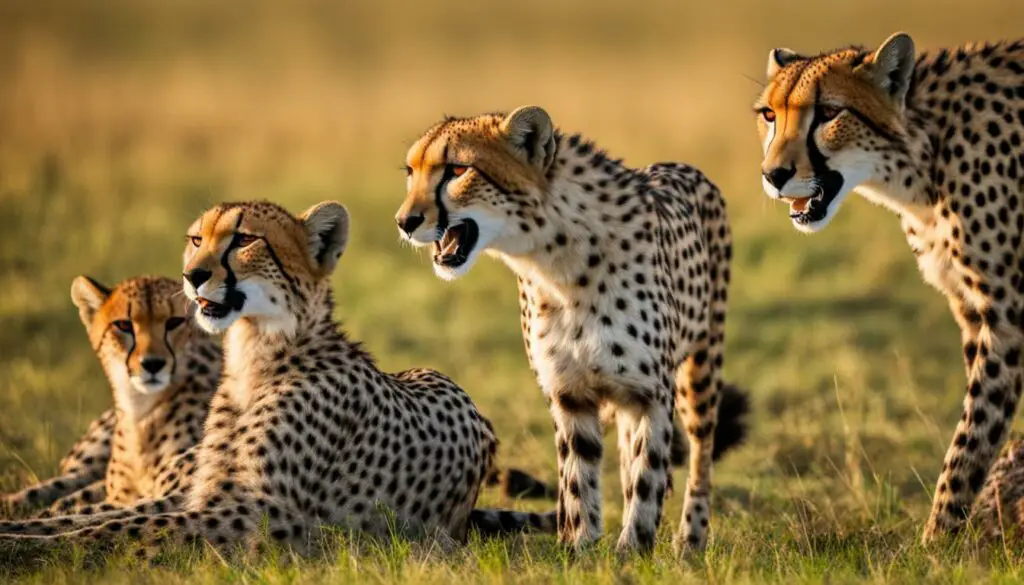
| Behavior | Description |
|---|---|
| Solitary behavior | Adult females are usually solitary, except during mating. |
| Male coalitions | Male cheetahs often form coalitions with their brothers or other males for defense and hunting. |
| Maternal care | Female cheetahs raise their cubs alone, teaching them hunting skills and keeping them hidden in dens. |
| Communication | Cheetahs communicate through vocalizations such as chirping, growling, hissing, and purring, as well as body language. |
| Hunting technique | Cheetahs use their exceptional speed and agility to sprint, knock down their prey, and deliver a fatal bite to the throat. |
| Deferred feeding | Cheetahs consume their prey quickly and retreat to a safe distance to avoid losing their meal to scavengers. |
Cheetah Conservation and Threats
Cheetahs are currently facing numerous threats that have contributed to their endangered status. Loss of habitat due to human expansion is one of the leading factors impacting cheetah populations. As more land is converted for agriculture and urban development, the cheetah’s natural habitat diminishes, reducing their available prey and increasing their conflict with humans.
Illegal wildlife trade is another significant threat to the cheetah population. Cheetah cubs are often captured and sold as exotic pets, resulting in the fragmentation of the wild population and a loss of genetic diversity. The illegal pet trade not only harms individual cheetahs but also disrupts the delicate ecological balance of their natural habitats.
Inbreeding and limited genetic diversity pose additional challenges to the long-term survival of cheetahs. With a dwindling population, cheetahs face a higher risk of genetic disorders, reduced fertility, and weakened immune systems. Maintaining a healthy genetic pool is crucial for the species’ ability to adapt and withstand environmental changes.
Cheetah Conservation Organizations and Initiatives
Despite these threats, various conservation organizations and initiatives are working tirelessly to protect cheetahs and ensure their continued existence in the wild. These efforts include strengthening law enforcement to combat illegal wildlife trade, supporting habitat preservation projects, and raising awareness about the importance of cheetah conservation.
By addressing the underlying causes of cheetah endangerment, such as habitat loss and illegal trade, these organizations aim to mitigate the immediate and long-term threats the species faces. Through collaborative efforts and partnerships with local communities, conservationists can create sustainable solutions that benefit both cheetahs and the ecosystems they inhabit.
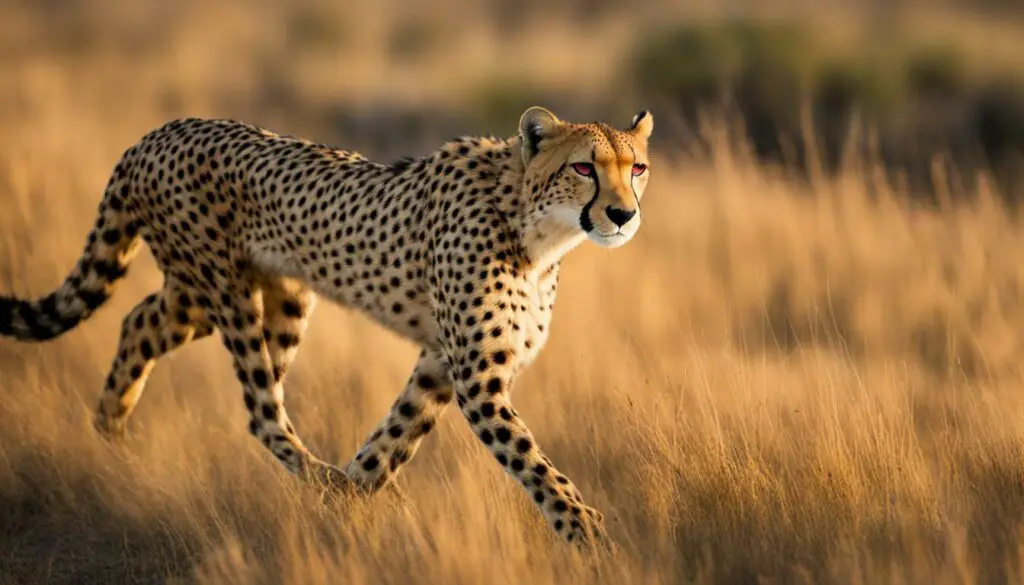
“Conservation is the key to securing a future for cheetahs in the wild. We must act now to protect their habitats, combat illegal trade, and raise awareness about the urgent need to save this magnificent species.”
– Dr. Sarah Carter, Wildlife Conservationist
By supporting these conservation initiatives through donations, volunteering, or spreading awareness, individuals can contribute to the preservation of cheetahs and their habitats. Together, we can make a significant impact and ensure a brighter future for these incredible creatures.
Conclusion
Cheetahs are fascinating creatures known for their incredible speed, unique adaptations, and hunting techniques. They are the fastest land animals on Earth, capable of reaching speeds up to 112km/h in just three seconds, thanks to their flexible spine, long legs, and lightweight structure. Their non-retractable claws and specialized paw pads provide increased traction while running, allowing them to chase down prey with great agility.
However, cheetahs face numerous challenges, including habitat loss, conflicts with humans, and illegal wildlife trade. The loss of their natural habitat due to human expansion threatens their populations. Additionally, conflicts with humans often arise when cheetahs prey on livestock, leading to retaliatory killings. The illegal pet trade further endangers their survival.
Conservation efforts are crucial to protect cheetahs and ensure their continued existence in the wild. These efforts include strengthening law enforcement to combat illegal wildlife trade, supporting habitat preservation, and raising awareness about the importance of cheetah conservation. By working together to address these challenges, we can contribute to the preservation of these magnificent creatures and safeguard their population for future generations.
What are the Similarities and Differences Between Cheetahs and Leopards?
Cheetahs and leopards are both large cats with spotted coats, but there are some key differences. Cheetahs are known for their incredible speed, while leopards are impressive climbers. Both have interesting leopard facts, such as their ability to drag prey up into trees to keep it safe from other predators.
FAQ
What makes cheetahs the fastest land animals?
Cheetahs have a lightweight structure, long legs, and a flexible spine that allows them to reach impressive speeds. They can go from zero to 60 miles per hour (97 kph) in just three seconds.
Where can cheetahs be found?
The majority of wild cheetahs can be found in sub-Saharan Africa, specifically in open grassy savannah plains and forests. A small population of cheetahs also exists in northeastern Iran, but their numbers are limited.
What are the major threats to cheetahs?
Cheetahs face threats such as loss of habitat, prey, and conflicts with humans. Illegal wildlife trade, particularly for the pet market, is also a significant threat. Inbreeding and limited genetic diversity pose challenges to their long-term survival.
How can we help protect cheetahs?
To protect cheetahs, we can support conservation organizations, raise awareness about their endangered status, and contribute to efforts aimed at habitat preservation and combating illegal trade.

